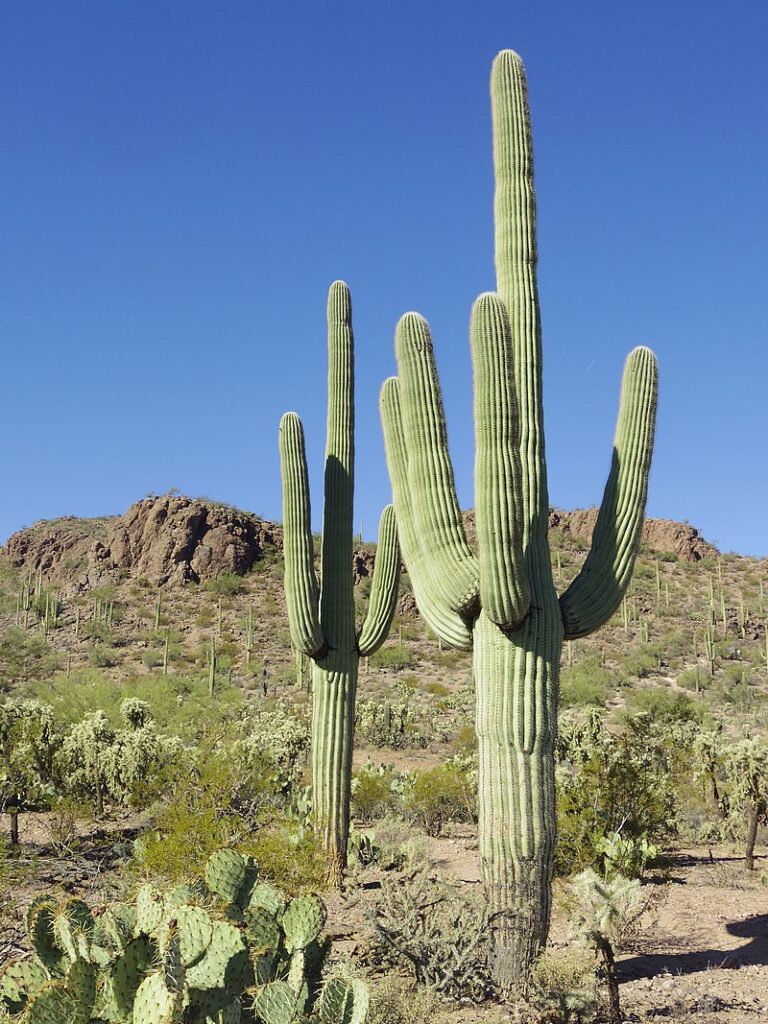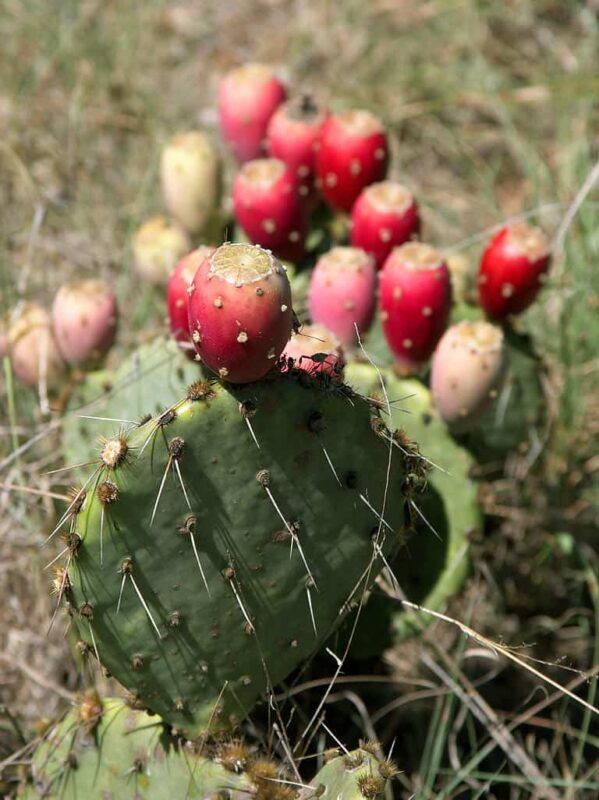Hollywood has made it easy to believe that cacti are a significant water source, especially in an emergency situation in the desert. This idea has further been fueled by the presence of cactus water on grocery store shelves. But are hikers really just wandering around in the desert, going from cactus to cactus and having themselves a drink? How safe is cactus water for human consumption? Is this all about just picking the right cactus to drink from?
If you’re going to hike in the desert, you’ll want to know what to do in a survival situation, so it’s time to take a closer look at what’s real and what’s myth about cactus water.
What Cactus Can You Drink Water From?
If absolutely necessary in a survival situation, a human can drink water from a fishhook barrel cactus (also called the southwestern barrel cactus, candy barrel cactus, and Arizona barrel cactus). However, this does carry risks and is far from an ideal situation.
The liquid that can be squeezed from the soft cactus pulp inside won’t be plentiful, and it won’t taste great. In the movies, you’ll often see cowboys hack open a barrel cactus and use a ladle to scoop out the water. That’s not the case in real life. There won’t be much water inside the plant. You will definitely still be thirsty.
Worse, the liquid you manage to consume carries a long list of potential side effects. The water from cactus plants is very acidic and can contain toxic alkaloids. Some of the potential side effects from this include temporary paralysis, vomiting, and have a laxative effect causing diarrhea. In a situation where you’re already dehydrated, these symptoms could worsen your condition. These side effects are a lot more likely to occur if you have an empty stomach, so if there is an opportunity to eat something before consuming the cactus water, that would greatly decrease the odds of ill effects.
Anyone potentially drinking cactus water in the desert should also be aware that there are five species of barrel cactus and that they only want to drink from the fishhook barrel cactus, not one of the other four. This is where knowing the types of cactus plants around you very well can become useful.
Clearly, drinking cactus water isn’t the ideal situation, and isn’t something hikers would want to do just for the fun and adventure of it. Even in a survival situation, cactus water from the fishhook barrel cactus is a decision that would have to be weighed carefully if you’re in a state of serious dehydration. Hikers who are looking to have some edible adventures can still seek out the barrel cactus as a great source of cactus fruits, which are usually available for harvest from late November through March. The bright yellow fruit grows on top of the cactus within easy-grabbing range, but you will need to be careful of the sharp spines on the cactus.

Can You Drink From A Saguaro Cactus?
The most widely-recognized cactus is the Saguaro cactus. Saguaro cacti grow in the Sonoran Desert in the southwest United States and northwest Mexico. They are often pictured in movies as the tall cactus that have arm-like branches stretched out proudly at their sides. These cacti should not be considered a safe water source. It’s important to know that in places like Arizona, these cacti are protected, and it is illegal to damage one, so cutting one open for water would also get you in legal trouble.
What About The Cactus Water Sold At The Grocery Store?
The commercially sold cactus water drinks on grocery store shelves are not made from the fishhook barrel cactus or any kind of barrel cactus for that matter. It’s actually made from prickly pear fruit. If you’ve ever purchased cactus water, you’ll notice it’s typically a light shade of pink, a diluted shade from the deep and bright-colored prickly pear cactus fruit.
The fruit of the prickly pear cactus has many potential health benefits and has become a popular commercial sports drink in recent years. It’s often considered an alternative to coconut water, which grew in popularity in years prior.
Prickly pear cacti are native to Latin America. They’ve been popular as a food source for generations in many parts of the world, especially South America, but aren’t currently as commonly known in most of North America.
The Health Benefits Of Cactus Water
Cactus water made from the bright pink fruit of the prickly pear has many potential health benefits, making it a popular plant-based beverage in the fitness community. The drink is usually marketed as one that is full of amino acids, vitamin C, and electrolytes with antioxidant properties. Many of the top cactus water brands avoid added sugars because they know that cactus water has proven popular with the diabetic community. The natural fructose in the cactus water has proven to be helpful in maintaining blood sugar levels. However, drinking too much cactus water along with taking blood-sugar-lowering medications can lead to hypoglycemia. Research has also shown that cactus water can reduce inflammation in the body because it targets free radicals.
If you’re drinking cactus water for health benefits, it’s important to note that while some research shows early evidence of many of these health benefits, more scientific research is still needed on the full benefits of cactus water, especially for people with diabetes. Early evidence has proven helpful, though, and it has certainly been part of why commercially sold cactus water has grown in popularity in recent years.
Interestingly, the actress and singer Vanessa Hudgens is also partly to blame for the rise in the popularity of cactus water. Hudgens has claimed that she used to frequently lose consciousness from dehydration. She dislikes drinking regular tap water so much that she just wouldn’t do it. Eventually, she began drinking cactus water as a solution. Today, she has teamed up with Oliver Trevena to create Caliwater, one of the many popular cactus water brands available on store shelves.
Could Prickly Pear Pads Help With Hydration?
As mentioned above, the only cacti you can cut into and drink from is the fishhook barrel cactus, and it isn’t an ideal decision to have to make. It’s an unfortunate truth that many hikers get lost in the desert. In that potential situation, there would be a lot of difficult decisions to make. One option to help with hydration and staying fed may be to eat prickly pear pads.
The prickly pear cactus bear the bright pink fruits used in commercial cactus water. They also have edible pads. The pads are often called nopales, and the plant itself is sometimes referred to as the nopal cactus. These pads are traditionally harvested and used to make vegetarian tacos, salads, and more. The prickly pear cactus pads are full of fiber, and vitamins, and are actually 85% water. In a survival situation, finding some prickly pear cactus to consume could be one way to improve your condition. On a fun hiking adventure where you’re looking for edible cacti, the prickly pear is a popular choice both for the pads and the bright pink fruit. Keep in mind that like with many varieties of cacti, the spines of the cactus will need to be carefully removed.
Fact From Fiction
Unfortunately, popular western films have fudged a little on the drinkability of the fishhook barrel cactus. You’re never going to cut one open and dip a ladle into a fresh pool of potable water. However, the commercially sold cactus water today is a healthy plant-based beverage, and many cacti still produce delicious and interesting new fruits to try, proving that the desert has more to offer than most people expect.
Recent Posts
The only venomous snakes in Washington State are Northern Pacific Rattlesnakes. The Northern Pacific Rattlesnake (Crotalus oreganus oreganus) is a sub-species of the Western Rattlesnake. Anyone...
Skunks are not classified as true hibernators. But they go into a state of torpor when the weather gets cold. Skunks are light sleep hibernators, along with opossums, bears, and raccoons. ...

